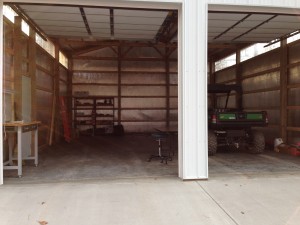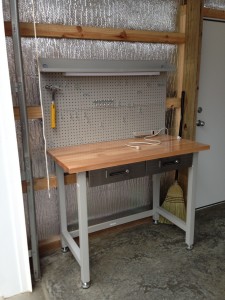I had no sooner moved into the shed (workbench, shelves, folding table, stool, gator, and forestry tools) than I realized I had an unanticipated problem.
The interior insulation of the shed was very vulnerable to pokes, perforations, tears and other minor accidents.

This type of accident was a real possibility, since I would be hanging forestry tools on the walls, and moving things around inside the shed. This was, after all, a working building, not a museum.
On the internet (my font of wisdom), others had faced this problem in a variety of ways, some more expensive than others. The simplest solution seemed to be to secure 4×8 sheets of wall covering, screwing them into the girts (2×4 cross-pieces) to hold them in place.
After setting aside decorative wall coverings (I didn’t need decoration), I was left with two options, 4×8 plywood, or 4×8 OSB (Oriented Strand Board). OSB functioned just like plywood, except better in many respects. It tended not to warp, was more uniform in size, and was less expensive. This all sounded good to me.
Many internet consultants recommended painting the boards white, to brighten the interior spaces and seal the wood. OK.
I presented my strategy to my brother-in-law carpenter, who had several suggestions:
- Paint the OSB panels on the ground, before they are mounted. It’s easier that way.
- Use a cordless Impact Driver to screw the panels in place. This is like an electric screw driver, except that whenever it meets resistance (like when trying to go through OSB and 2×4’s), tiny hammers inside the driver beat a million times a second on the screw, hammering it and twisting it into the wood.
- Mount the panels vertically, and rest them on scrap pieces of 1×1 boards, to elevate them about an inch off the ground. After the panels are screwed in, the 1/1’s can be removed. This eliminates moisture from the concrete slab being picked up by the OSB.

I went to my favorite local store, Buchheit’s, located the 4×8 OSB panels (1/2″), and made an unhappy discovery…Buchheit’s doesn’t deliver. They would help me load the panels into my truck (I don’t have a truck), but otherwise, I was on my own. I thanked them for their time, and moved on.
My next visit was to RP Lumber, who also had my 4×8 OSB panels. Happily, they would deliver them to my shed, and they were also less expensive.
That afternoon, the big RP Lumber truck arrived. The 25 panels were loaded on skids and hoisted up by a forklift. The forklift drove right into the shed and gently set the 4×8 OSB panels onto scrap 1x1s on the floor.
I was ready to begin.
